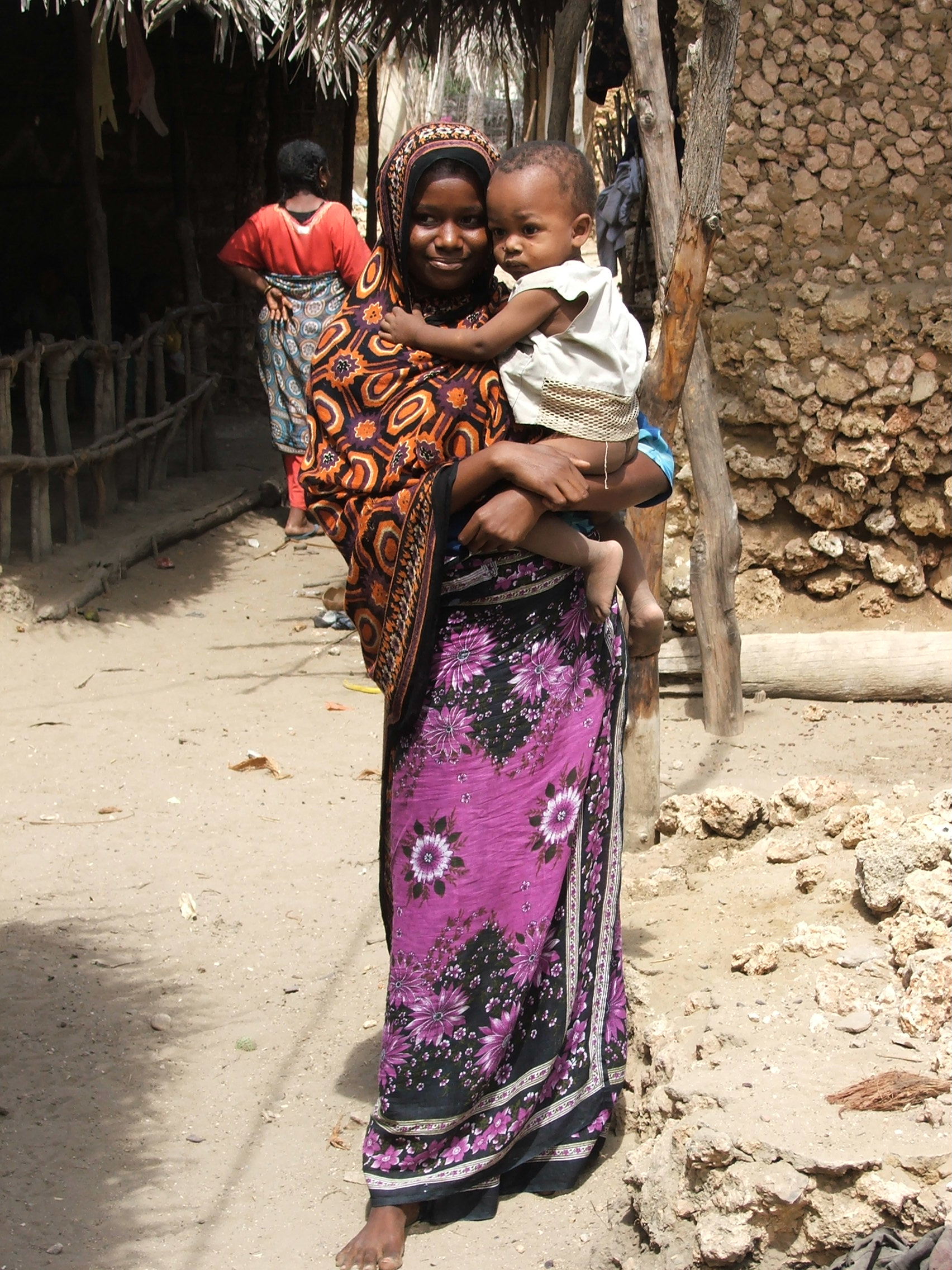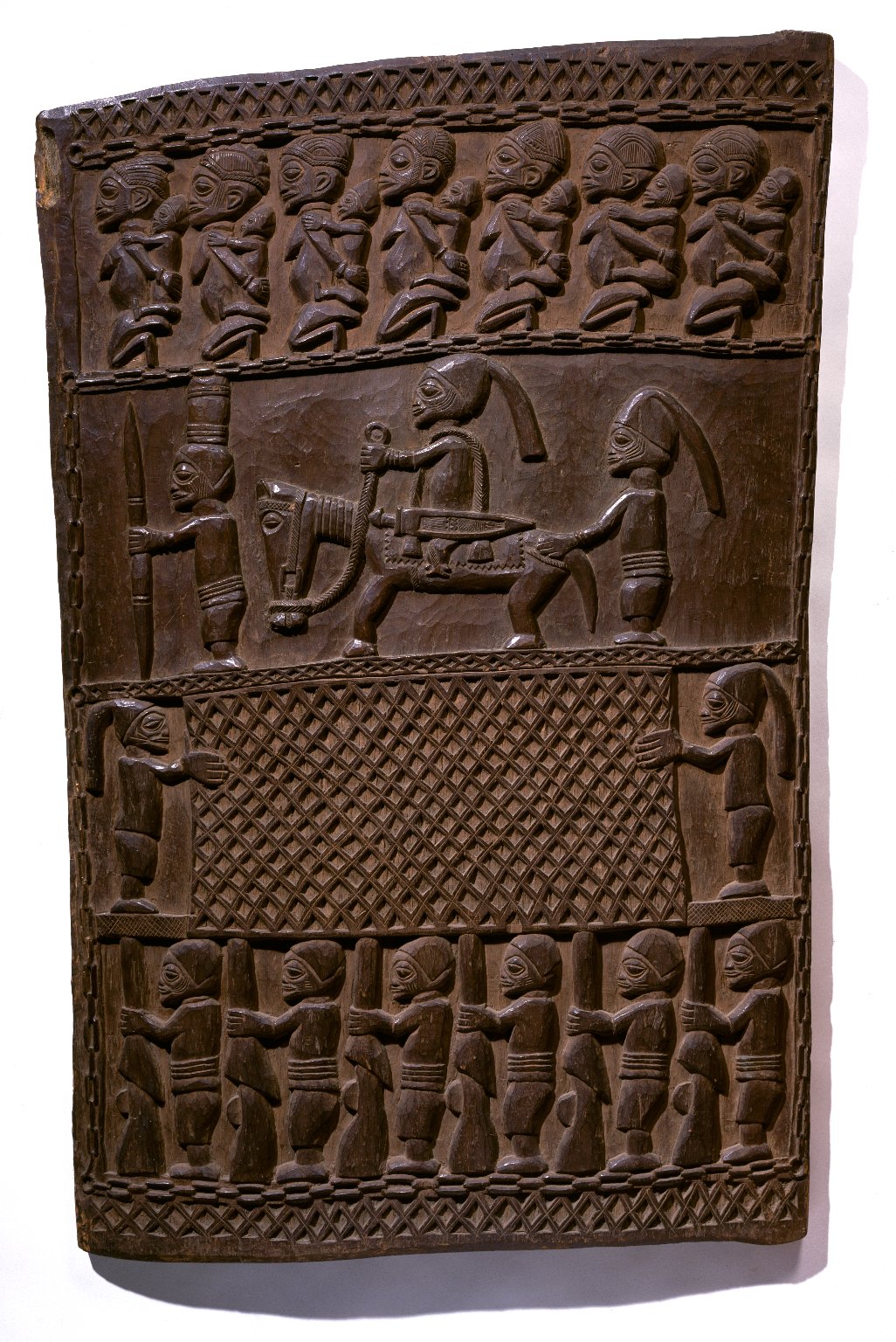|
Kuba Textiles
Kuba textiles are a type of raffia cloth unique to the Democratic Republic of the Congo, formerly Zaire, and noted for their elaboration and complexity of design and surface decoration. Most textiles are a variation on rectangular or square pieces of woven palm leaf fiber enhanced by geometric designs executed in linear embroidery and other stitches, which are cut to form pile surfaces resembling velvet. Traditionally, men weave the raffia cloth, and women are responsible for transforming it into various forms of textiles, including ceremonial skirts, ‘velvet’ tribute cloths, headdresses and basketry. Raffia cloth In Kuba culture, men are responsible for raffia palm cultivation and the weaving of raffia cloth. Several types of raffia cloth are produced for different purposes, the most common form of which is a plain woven cloth that is used as the foundation for decorated textile production. Men produce the cloth on inclined, single-heddle looms and then use it to make th ... [...More Info...] [...Related Items...] OR: [Wikipedia] [Google] [Baidu] |
Cut Pile
Pile is the raised surface or nap of a fabric, consisting of upright loops or strands of yarn."Pile." ''The Oxford English Dictionary''. 2nd ed. 1989. Examples of pile textiles are carpets, corduroy, velvet, plush, and Turkish towels. The word is derived from Latin ''pilus'' for "hair". " Online Etymology Dictionary. Douglas Harper, Historian. retrieved from 10 September 2007. Length and density The surface and the yarn in these fabrics are also called "pile". In particular "pile length" or "pile depth" refer to the length of the yarn strands (half-length of the loops). Pile length affects and is affected by[...More Info...] [...Related Items...] OR: [Wikipedia] [Google] [Baidu] |
Democratic Republic Of The Congo Culture
The culture of the Democratic Republic of the Congo is extremely varied, reflecting the great diversity and different customs which exist in the country. Congolese culture combines the influence of tradition to the region, but also combines influences from abroad which arrived during the era of colonization and continue to have a strong influence, without destroying the individuality of many tribal customs. People, language and background Like many African countries, the borders were drawn up by colonial powers, and bore little relation to the actual spread of ethno-linguistic groups. There are 242 languages spoken in the country, with perhaps a similar number of ethnic groups. Broadly speaking, there are four main population groups: * Pygmies, the earliest inhabitants of the Congo, are generally hunter-gatherers. Expert in the ways of the forest, where they have resided for thousands of years, they live by trading meat with their taller farming neighbors in exchange for agric ... [...More Info...] [...Related Items...] OR: [Wikipedia] [Google] [Baidu] |
African Clothing
African clothing is the traditional clothing worn by the peoples of Africa. African clothing and fashion is a diverse topic that is able to provide a look into different African cultures. Clothing varies from brightly colored textiles, to abstractly embroidered robes, to colorful beaded bracelets and necklaces. Since Africa is such a large and diverse continent, traditional clothing differs throughout each country. For example, many countries in West Africa have a "distinct regional dress styles that are the products of long-standing textile crafts in weaving, dyeing, and printing", but these traditions are still able to coexist with western styles. A large contrast in African fashion is between rural and urban societies. Urban societies typically are exposed more to trade and the changing world, while it takes more time for new western trends to get to rural areas. By region In Northeastern Africa, particularly in Egypt, styles of traditional women's clothing have been influe ... [...More Info...] [...Related Items...] OR: [Wikipedia] [Google] [Baidu] |
Sankuru District
Sankuru District (french: District du Sankuru, nl, District Sankuru) was a district of the Belgian Congo and Democratic Republic of the Congo. It went through various changes in extent, but roughly corresponded to the modern Sankuru Province. Location A 1914 map shows Sankuru roughly in the center of the Belgian Congo, bordered by Kasai District and Lac Leopold II District to the west, Équateur District and Aruwimi District to the north, Maniema District in the Orientale Province to the east, and Lomami District in Katanga to the south. Sankuru District covered the upper part of the Lukenie River basin and a section of the Lubilash River, which originates further south in Lomami District. Colonial history Between 1910 and 1912 Kasai District was divided into Sankuru District to the northeast and a smaller Kasai District to the southwest. As of 1926 both these districts were in the Congo-Kasaï province. The people of the west of Sankuru District were stirred up at the en ... [...More Info...] [...Related Items...] OR: [Wikipedia] [Google] [Baidu] |
Off-beat (music)
In music and music theory, the beat is the basic unit of time, the pulse (regularly repeating event), of the ''mensural level'' (or ''beat level''). The beat is often defined as the rhythm listeners would tap their toes to when listening to a piece of music, or the numbers a musician counts while performing, though in practice this may be technically incorrect (often the first multiple level). In popular use, ''beat'' can refer to a variety of related concepts, including pulse, tempo, meter, specific rhythms, and groove. Rhythm in music is characterized by a repeating sequence of stressed and unstressed beats (often called "strong" and "weak") and divided into bars organized by time signature and tempo indications. Beats are related to and distinguished from pulse, rhythm (grouping), and meter: Metric levels faster than the beat level are division levels, and slower levels are multiple levels. Beat has always been an important part of music. Some music genres such as funk ... [...More Info...] [...Related Items...] OR: [Wikipedia] [Google] [Baidu] |
Robert Farris Thompson
Robert Farris Thompson (December 30, 1932 – November 29, 2021) was an American art historian and writer who specialized in Africa and the Afro-Atlantic world. He was a member of the faculty at Yale University from 1965 to his retirement more than fifty years later and served as the Colonel John Trumbull Professor of the History of Art. Thompson coined the term "black Atlantic" in his 1983 book ''Flash of the Spirit: African and Afro-American Art and Philosophy'' – the expanded subject of Paul Gilroy's book ''The Black Atlantic''. He lived in the Yoruba region of southwest Nigeria while he conducted his research of Yoruba arts history. He was affiliated with the University of Ibadan and frequented Yoruba village communities. Thompson studied the African arts of the diaspora in the United States, Mexico, Argentina, Cuba, Haiti, Puerto Rico, and several Caribbean islands. Career at Yale In 1955, Thompson received his B.A. from Yale University. After receiving his bachelor's d ... [...More Info...] [...Related Items...] OR: [Wikipedia] [Google] [Baidu] |
Wallpaper Group
A wallpaper is a mathematical object covering a whole Euclidean plane by repeating a motif indefinitely, in manner that certain isometries keep the drawing unchanged. To a given wallpaper there corresponds a group of such congruent transformations, with function composition as the group operation. Thus, a wallpaper group (or plane symmetry group or plane crystallographic group) is in a mathematical classification of a two‑dimensional repetitive pattern, based on the symmetries in the pattern. Such patterns occur frequently in architecture and decorative art, especially in textiles, tessellations and tiles as well as wallpaper. What this page calls pattern Any periodic tiling can be seen as a wallpaper. More particularly, we can consider as a wallpaper a tiling by identical tiles edge‑to‑edge, necessarily periodic, and conceive from it a wallpaper by decorating in the same manner every tiling element, and eventually erase partly or entirely the bou ... [...More Info...] [...Related Items...] OR: [Wikipedia] [Google] [Baidu] |
Frieze Group
In mathematics, a frieze or frieze pattern is a two-dimensional design that repeats in one direction. Such patterns occur frequently in architecture and decorative art. Frieze patterns can be classified into seven types according to their symmetries. The set of symmetries of a frieze pattern is called a frieze group. Frieze groups are two-dimensional line groups, having repetition in only one direction. They are related to the more complex wallpaper groups, which classify patterns that are repetitive in two directions, and crystallographic groups, which classify patterns that are repetitive in three directions. General Formally, a frieze group is a class of infinite discrete symmetry groups of patterns on a strip (infinitely wide rectangle), hence a class of groups of isometries of the plane, or of a strip. A symmetry group of a frieze group necessarily contains translations and may contain glide reflections, reflections along the long axis of the strip, reflections along the ... [...More Info...] [...Related Items...] OR: [Wikipedia] [Google] [Baidu] |
Geometric
Geometry (; ) is, with arithmetic, one of the oldest branches of mathematics. It is concerned with properties of space such as the distance, shape, size, and relative position of figures. A mathematician who works in the field of geometry is called a ''List of geometers, geometer''. Until the 19th century, geometry was almost exclusively devoted to Euclidean geometry, which includes the notions of point (geometry), point, line (geometry), line, plane (geometry), plane, distance, angle, surface (mathematics), surface, and curve, as fundamental concepts. During the 19th century several discoveries enlarged dramatically the scope of geometry. One of the oldest such discoveries is Carl Friedrich Gauss' ("remarkable theorem") that asserts roughly that the Gaussian curvature of a surface is independent from any specific embedding in a Euclidean space. This implies that surfaces can be studied ''intrinsically'', that is, as stand-alone spaces, and has been expanded into the theory of ... [...More Info...] [...Related Items...] OR: [Wikipedia] [Google] [Baidu] |
Kuba Art
Kuba art comprises a diverse array of media, much of which was created for the courts of chiefs and kings of the Kuba Kingdom. Such work often featured decorations, incorporating cowrie shells and animal skins (especially leopard) as symbols of wealth, prestige and power. Masks are also important to the Kuba. They are used both in the rituals of the court and in the initiation of boys into adulthood, as well as at funerals. The Kuba produce embroidered raffia textiles which in the past was made for adornment, woven currency, or as tributary goods for funerals and other seminal occasions. The wealth and power of the court system allowed the Kuba to develop a class of professional artisans who worked primarily for the courts but also produced objects of high quality for other individuals of high status. Culture and history Kuba was a multicultural kingdom in Central Africa, which developed during the early seventeenth century and reached its peak in the second half of the ninetee ... [...More Info...] [...Related Items...] OR: [Wikipedia] [Google] [Baidu] |
Yoruba Art
The Yoruba of West Africa (Benin, Nigeria and Togo, with migrant communities in parts of Ghana and Sierra Leone) are responsible for one of the finest African art, artistic traditions in Africa, a tradition that remains vital and influential today. Much of the art of the Yoruba, including staffs, court dress, and beadwork for crowns, is associated with the royal courts. The courts also commissioned numerous architectural objects such as veranda posts, gates, and doors that are embellished with carvings. Other Yoruba art is related shrines and masking traditions. The Yoruba worship a large pantheon of deities, and shrines dedicated to these gods are adorned with carvings and house an array of altar figures and other ritual paraphernalia. Masking traditions vary regionally, and a wide range of mask types are employed in various festivals and celebrations. History In the period around 1300 CE the artists at Ife developed a refined and naturalistic sculptural tradition in terraco ... [...More Info...] [...Related Items...] OR: [Wikipedia] [Google] [Baidu] |





